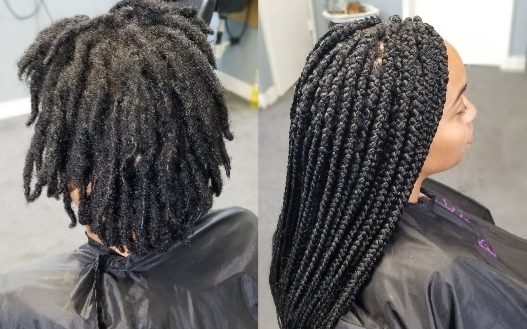
Many people wonder if braids can turn into dreads, especially those who are thinking about getting dreadlocks as a hairstyle. Even though the response isn’t as straightforward as yes or no, let’s explore the realm of hair locking and learn the real story behind this hair change.
Can Braids Turn Into Dreads
Braids and dreadlocks, also known as dreads, are popular hairstyles celebrated for their unique visual appeal and cultural significance. While both hairstyles involve manipulating hair strands, the mechanisms behind their formation are fundamentally different. In contrast to braids, which involve braiding hair strands into elaborate patterns, individuals form dreadlocks by allowing hair to naturally mat and lock together over time. Despite their peculiarities, it’s a popular misunderstanding that braids can transition into dreadlocks. However, braids are temporary styles that individuals can easily unravel or remove, while dreadlocks are formed through a natural matting and locking process that occurs gradually.
Why Braids Cannot Turn Into Dreads
Dreads are formed naturally through matting and interlocking hair strands, often without combing or brushing. Contrarily, braids entail weaving and fastening hair strands in a certain pattern, which inhibits the natural matting and interlocking required for the production of dread. Because tangling and knotting at the hair’s ends might act as a springboard for the production of dread after the braids are removed, the braid effect may aid in the locking process after the braids are taken out.
Formation of Dreads
Dreadlocks can be achieved through various methods, including the Neglect Method, which involves stopping combing or brushing hair, allowing it to naturally mat and lock over time, and the Twist and Rip Method, which involves twisting small sections of hair and pulling them apart to create a loose dreadlocked base. The Crocheting Method, often performed by a professional hairstylist, uses a crochet hook to interlock sections of hair, creating a tighter, more uniform dreadlocked style.
Maintaining Dreads and Braids
While braids require regular maintenance to prevent frizz and maintain their appearance, dreadlocks require a different approach to care. Minimal interference is ideal for dreadlocks, and excessive manipulation can cause the locking mechanism to malfunction. Healthy dreadlock formation can be encouraged by routinely washing hair with residue-free shampoo, and occasionally using palm rolling or other maintenance treatments. On the other hand, braids offer more styling and maintenance options because they may be undone and re-braided as needed.
Frequently Asked Questions and Answers on Can Braids Turn Into Dreads?
1. Can braids turn into dreadlocks?
No, braids cannot turn into dreadlocks on their own. While both hairstyles involve manipulating hair strands, the processes behind their formation are fundamentally different. Braids are temporary styles that can be easily unravelled or removed, whereas dreadlocks are formed through a natural matting and locking process that occurs over time.
2. How are dreadlocks formed?
Dreadlocks, also known as “locs,” are formed when hair is left to naturally mat and lock together. This process typically occurs over several months to years, depending on factors such as hair texture, length, and maintenance routine. As the hair locks, it forms cylindrical or rope-like strands that gradually become tighter and more defined.
3. Can I start dreadlocks with braids?
While it’s possible to create the initial structure of dreadlocks using braiding techniques such as “twist and rip” or “backcombing,” true dreadlocks are formed through a natural matting and locking process that occurs over time. Braids alone cannot turn into dreadlocks; however, they can be a starting point for individuals who wish to transition to dreadlocks.
4. How do I maintain braids and dreadlocks?
Braids require regular maintenance to prevent frizz and maintain their appearance. They can be taken down and re-braided as desired, allowing for versatility in styling and maintenance. Dreadlocks, on the other hand, thrive on minimal interference. Regular washing with residue-free shampoo and occasional palm rolling or maintenance techniques can help promote healthy dreadlock formation.
5. Can I undo dreadlocks and return to braids?
Yes, dreadlocks can be undone, but it’s a time-consuming process that often involves cutting or combing out the locks. Once the dreadlocks are removed, the hair can be styled into braids or other hairstyles. However, it’s essential to consult a professional hairstylist experienced in working with dreadlocks for the best results.
6. Are there any misconceptions about braids and dreadlocks?
Yes, one common misconception is that braids can turn into dreadlocks over time. In reality, braids and dreadlocks are distinct hairstyles with different formation processes.
Conclusion
Braids can provide a protective style for your hair and may even help in the early phases of dread production following removal, even if they won’t miraculously become dreads. But if you’re serious about diving into the realm of dreadlocks, trying out some of the suggested techniques listed above will help you get the look you want.

Leave a Reply